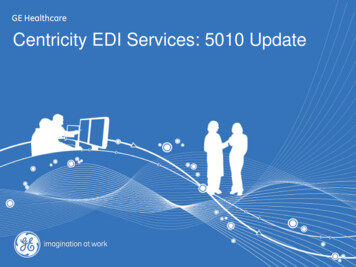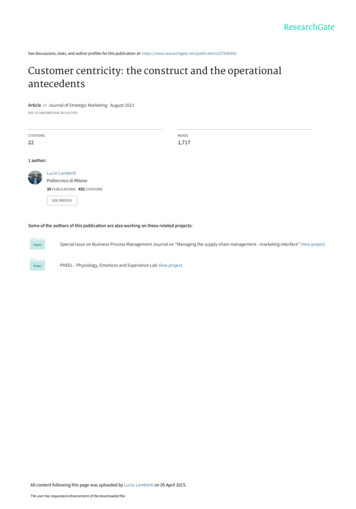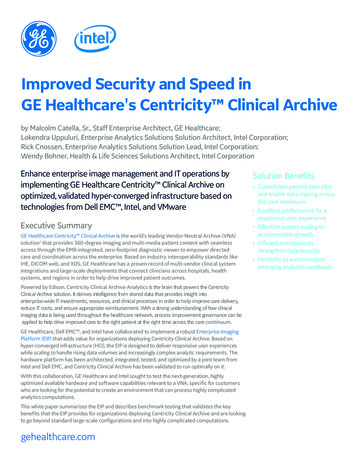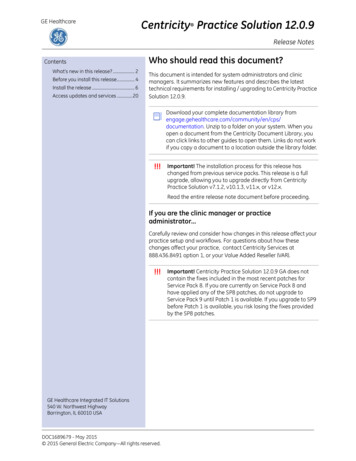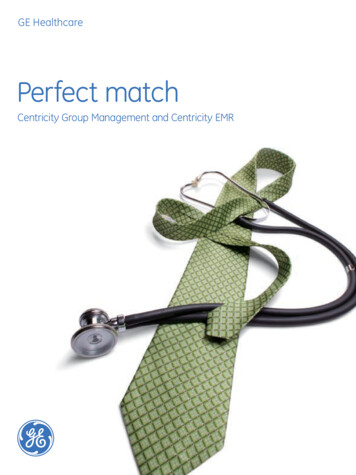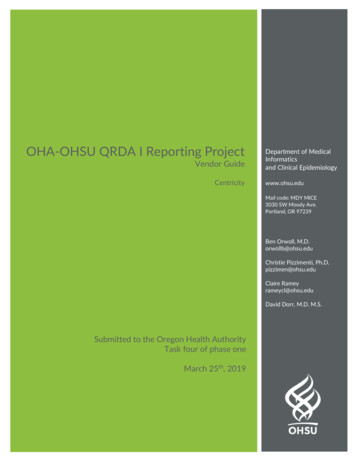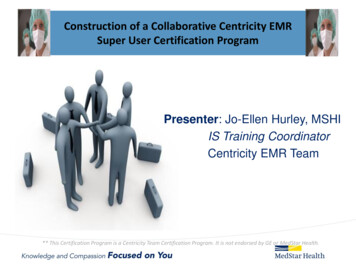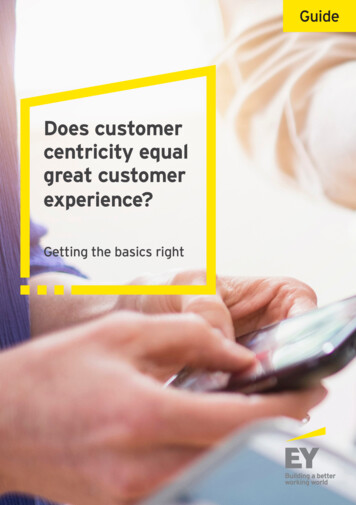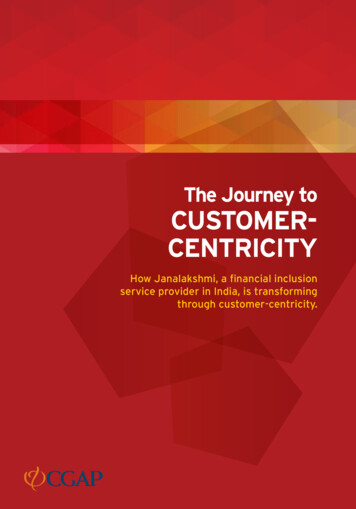
Transcription
The Journey toCUSTOMERCENTRICITYHow Janalakshmi, a financial inclusionservice provider in India, is transformingthrough customer-centricity.
Elements of the gningEffectiveOrganizationalDeliveryMaking theEconomics/BusinessCase Work
The ProjectMost microfinance institutions provide a narrowly focused product range,usually only microcredit. Until recently, this was the major focus of JanalakshmiFinancial Services, a microfinance institution in India serving over a millioncustomers in urban areas. Janalakshmi built its portfolio around a Grameenstyle group loan product. In 2011, Janalakshmi took the first steps towardcustomer-centricity, segmenting its customer base and designing the“Jana-One” delivery channel to offer a full range of financial services tothe owners of high-growth potential microenterprises, a segment they called“accelerators.” While this move was an innovation for Janalakshmi’s businessmodel, the institutional mechanisms were still set up to deliver credit. Recognizing this tension between the vision and execution, Janalakshmi partneredwith CGAP to explore new approaches in understanding its customers and toimplement the principles of customer-centricity throughout the operationalstructures of the organization. The Janalakshmi journey toward embedded andinternalized customer-centricity will span three broad phases (Understanding Customers, Designing Effective Organizational Delivery, and Makingthe Business Case Work). This brochure shares the learnings from the firstphase of work to understand customers. Janalakshmi, CGAP, and InnovationLabs (a Bangalore-based design-innovation consultancy) worked togetherover six months on this project.1
The challengeFinancial service providers struggle with understanding customers and theirevolving needs over time, and with systematically translating that understandinginto better products and services.The solution/innovationThe first phase of Understanding Customers focused on the creation of an“Insights Engine” that helps to develop profiles of customers over time.The processTo develop a deeper and organizational level of understanding customers, a crossfunctional team at Janalakshmi (with members from product development, servicedelivery, and marketing) applied the design thinking process facilitated by innovation consultants. This consisted of studying the customers in the field usingqualitative anthropological methods——for example, understanding the customerreality, aspirations, and views at such a granular level that it can serve as a basisfor the design of a household profiling tool.The research team identified six diverse microentrepreneur households andspent an entire day with each of them, immersing themselves in the householdand their neighborhood. They had in-depth conversations with family membersabout life events, religious rituals, aspirations, income sources, expenses, supportstructures, and other issues. They also collected data on daily cash transactionsfor the microenterprises linked with these households.2
Customer Insights Generated by the ProcessCustomers are great at “Cash Management” but not as adept at“Wealth Management”The poor lead extremely complex financial lives and have sophisticated systemsto manage cash day to day. We interviewed the owner of a corner store who usesdifferent cardboard boxes to manage different categories of expenditure. Inaddition, he has multiple loans and is managing their repayments. However,the pressures of his everyday life and limited knowledge of financial instrumentsprevent him from thinking about creating wealth in the long term.Children act as motivators for savingCulturally, households place their hopes on the shoulders of their children andinvest heavily in them. Most households saved in some form for their children,typically for the marriage of daughters or for the education of sons. The avenuesfor saving were most often gold, material goods, or an informal investment, suchas a local chit fund.Microentrepreneurs are highly conscious of opportunity costs of daily incomeMost households worked long and often extended hours to run their business, withvery little time for anything else. Taking time off from the business is considered aloss of daily income, causing driven households to sacrifice social activities. Takingtime away from their business to travel to a financial institution was viewed as anopportunity cost.Unexpected family events have long-term financial implicationsThe trajectory of a family resembles a game of “Snakes and Ladders” (Snakes andChutes for our American readers). Positive events, such as an inheritance orstarting of a new business, create a positive outlook, and unexpected events, suchas fatal accidents, medical emergencies in the family, or being cheated by localmoneylenders, leave the family’s finances in shambles for years.Family attitudes indicate financial behaviorThe attitude of the primary breadwinner, the spouse, or even children greatlyinfluences the financial outlook of the family. A couple that is content and notlooking for an aggressive growth in lifestyle approaches their finances verydifferently from a household with high material needs and an aspirationaloutlook for the future.3
The Tool: KaleidoThe team synthesized the insights about customers into five areas or sections that,when viewed together, will provide a nuanced understanding of the household andover time will serve as the basis for identifying financial needs and designingproducts, services, and delivery mechanisms that will fulfill these needs.The Kaleido tool was co-created from a number of iterations by variousstakeholders at Janalakshmi, CGAP, and Innovation Labs. Kaleido can be used tounderstand and map the financial context of a household. Information provided bythe family through a questionnaire they complete upon enrollment is used todevelop a visual map that indicates high-level attributes representing a 360 degreeview of the household’s financial indicators. Information is added to the client’sprofile as the relationship progresses. Over time, Kaleido is expected to evolve intoa rich source of data for developing new products as well as assessing the financialprogress of a family.Kaleido aggregates the financial view of a household into a visual graph withfive sections related to the household. These are composition, events, attitudes,business, and finances. Each section has several subcomponents that provide morefine-tuned information. The assumption is that the specific reality of each contextual component will influence the design criteria in such a way that products andservices designed on the basis of this tool will speak directly to the specific profile,in terms of financial product and service needs.Kaleido as a platform Kaleido operates with a household–microenterprise as the unit Kaleido gives front-line staff the nuanced profile of a family in one view The power of Kaleido also lies in the data it will generate. Over time Kaleidowill have information on the journey of a large number of households Kaleido acts as a tool to continuously and systematically source customerinsights Future applications of Kaleido data include subsegmentation, productmapping, and new product and service design5
Kaleidols,kilsnt lme cia eenhgna fina ts tan t.rmeolfm ncia on ru vean nd inst of enees fi p ially’ y de anc typihm he fincaeaef kt fth wor pe o ingtrtty duou esab he n the ysntsoetldm ut anEvormpInf abo port ily epmghsu fahithMma easin y le ureov ad oferfiall to a nansp n i ciaEanrningAt endin crea l attistugtitud or eae or d deesrn ecing reasSp.eeatndingiumedmnoiotniratiMigpos ousehold inhComtiof theposiot o ily com.apshmA sn s of fa ructureterm and lneprimaryBracketTypeSourceFinancesMetrics to gauge the financialcondition of a household.6MeaBusUtilsureinesizats thionson h e impactousoehold fi f an ennances. terpriselow
CompositionThis section provides a quick snap shot of the household in terms of family composition andstructure. For example, a family strongly linked to another area, with a recent migration profile,will have financial product needs specific to remittances.Migration—Indicating when the family has moved to the current house.Structure—Information about members currently living in the household.Distant—Members of the family living away.FinancesMetrics to gauge the financial condition of a household.Income Bracket: Segmentation of household based on income.Type: Segmentation based on the household’s assets, liability, inflow, and outflow ratios.Source: Tracking the household’s income sources.BusinessSince microenterprises are closely linked to households, the business section isused to understand and measure the impact of the enterprise on the householdfinances and vice versa.Vulnerability: This factor measures the inherent vulnerability of the enterprise.Type: Segmentation of business type based on cash flow scenarios.Utilization: The degree to which an enterprise has reached its maximum earning potential.AttitudesThis measures the financial attitude of a family influencing the emphasis, for example,on consumption versus saving.Earning Attitude—Captured by the goals and aspirations of the family giving an indicationof a family’s drive to earn.Spending Attitude—Captured by understanding the family’s inclination toward spending forreasons such as religion, education, social occasions, self-indulgence, altruism, etc.EventsMost events (e.g., marriage, sickness, start of new business, etc.) that occur in a familyhave implications for the household’s finances. Responses to events also provide valuableinformation about the family’s current asset and financial situation, financial managementskills, the network they depend on for financial support, and the type of financial instrumentsthe family employs during different events. Events can be categorized as lifecycle eventsand trauma events, which have very different product implications.7
Illustration of contrasting customer profilesHousehold A: TailorAttitgoalsud3gter m54tsenvEspendingattitudeShorttermMediumtermLon( ve)1esMediuentmIearning brackettypeoutflBtype1SecondaryPrimaryasset income1liability expensesLowTertiaryowstructureMembersstaying awayHighinflow4Mediumnsitiompo1 erabilityfactor3 Business( ve)andBornught up thanbroMoreYear BetweenYr3to 3than1 YrLess year81w1Belo6018 to0ve 6Aboincome source2 Finances1 Five-member family with only one earning member, has a dependent motherstaying away from the household.2 Has two income sources, one primary and the other tertiary.3 Business has a high utilization factor, and the tailor is thinking of diversifyinghis business.4 Family has adequate surplus to meet its mid-term goals.5 Events that have occurred in the family had a net positive financial impact onthe household’s finances.8
Household B: Auto Rickshaw umtermLong(-ve)1esShortterm( ve)1entMediumHighinflow3Aowstructureearning rimaryPrimaryPasset incomeliability expensesLowMediumHighnsitiompo1 Co4membersstaying lnerabilityfactor3 Business(-ve)andBornught upthanbroMoreYear BetweenYr3to 3than1 YrLess year1w 18Belo0618 to06ve 6Aboincome source2 Finances1Three-member family with both parents working, and a dependent son.2Has two income sources, one primary and the other secondary.3Business has a high utilization factor, but the family is content and not looking foraggressive growth.4Family has adequate surplus to meet its short-term goals, but is falling short offunds to meet its mid-term goals.5Events that have occurred in the family had a net negative financial impact onthe household’s finances.9
The biggest achievement of this exercise is that we are talking about thecustomer. We now placed the customer in the center . . . which weotherwise lose sight of.—Ramesh Ramanathan, Founder & Chairman, JanalakshmiThis project helped us develop a framework to understand customers.It is a platform with which we can have greater understanding of thecustomers. We need to think through how we are going to implement it.—Santanu Mukherjee, Senior Vice President, Janalakshmi Financial ServicesI could not have imagined an organization conducting a study ofthis sort to understand what exactly the customers need and want.It was a good way to take a step back, get into the customers’ shoesand see what they need and what their requirements are. And thento be able to offer a product that addresses their needs directly.— NS Muthukumaran, Vice President, Client Insights and Analytics,Jana Urban FoundationWhen you go and actually visit the customers, you are able to empathizemuch more with them. They are going through various things in their livesand you get to see it for yourself——it is very real. . . . The other thing thatstruck me in the immersions was that people in this socioeconomicclass are extremely busy. . . . If you don’t visit them, you don’t realizejust how packed their days are. Anything that we deliver in terms offinancial services has to take this into account.— Neelanjana Gupta, Senior Executive, Skills and Livelihood Program,Jana Urban FoundationI never thought a customer would allow us to spend the entire day with them.With this experience, we shifted our product development around: we firstwent to the customer to understand who they are, what their likes are——and then created the products and services. The learning that you getthis way is phenomenal.— Divya Nandakumar, Program Manager, Education, Skills and Livelihood Program,Jana Urban Foundation10
11
Taking the First Step with Kaleido Customer-centricity delivers superior long-term value to customers and toproviders of financial services. The first step is developing a systematic and on-going understanding ofcustomers: Kaleido is a tool that launches providers on the path to customercentricity. Kaleido was developed bottom-up by conducting immersions with householdmicroenterprises and synthesizing insights from the immersions into ahousehold profiling tool. Kaleido builds a nuanced profile of a household along five dimensions:household composition, events, attitudes, business, and finances. As Kaleido is empowered with data, it can be used to map the right productsto the right profile, subsegment customers based on their profiles, anddevelop new products and services for specific subsegments over time.Call for ActionCGAP is seeking institutions to partner with us to test and improve Kaleido.Through a competitive process, CGAP will select a small number of institutions towork on demonstration projects. If you are a financial service provider that isinterested in making the shift to customer-centricity, we invite you to contact us.Stay engaged with CGAP as we continue our learning journey on customercentricity. To receive updates and engage with a community of like-mindedindividuals, contact the Project Manager, Tanaya Kilara: tkilara@worldbank.org CGAP 201412
Photo credits:Page 4: Dhiman BanerjeeAll other photos: Shwet Sharvary
The Journey to CUSTOMER- CENTRICITY How Janalakshmi, a financial inclusion service provider in India, is transforming through customer-centricity. . mapping, and new product and service design 5. Finance s C omposition s s t s v s Earnin g U tilization T ype u lnerability Brac ke t n T ype tertiary secondary primary high medium lo w


